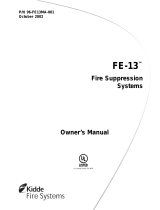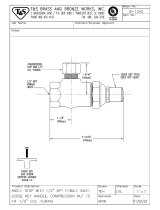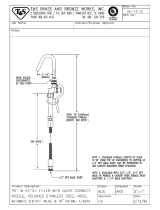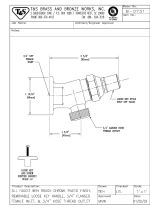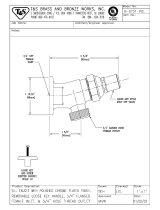Page is loading ...

P/N 81-CO2MAN-001
September 2013
R
LISTED
FM
APPROVED
UL Listing File No. EX 4674
Engineered
Carbon Dioxide (CO
2
)
Fire Suppression Systems
Design, Installation,
Operation and
Maintenance Manual


P/N 81-CO2MAN-001 i September 2013
FOREWORD
Note: This Kidde Fire Systems Engineered Carbon Dioxide (CO
2
) Fire Suppression System Design,
Installation, Operation, and Maintenance manual, P/N 81-CO2MAN-001, is for use only by qualified
and factory-trained personnel with working knowledge of applicable standards such as NFPA, as well
as a working knowledge of Kidde Fire Systems Engineered Carbon Dioxide (CO
2
) Fire Suppression
System. Kidde Fire Systems does not authorize or recommend use of this Manual by others.
The data contained herein is provided by Kidde Fire Systems as a guide only. It is not intended to be all
inclusive and should not be substituted for professional judgement. Kidde Fire Systems believes the data
to be accurate, but this data is provided without guarantee or warranty to its accuracy or completeness.
Any questions concerning the information presented in this manual should be addressed to:
Kidde Fire Systems
400 Main Street
Ashland, MA 01721
Phone: (508) 881-2000
Toll Free: (800) 872-6527
Fax: (508) 881-8920
TERMS AND ABBREVIATIONS
MATERIAL SAFETY DATA SHEETS
Hard copies of the Material Safety Data Sheets (MSDS) are not included with this manual. The latest version
of the MSDS you are searching for can be found online at the Kidde Fire Systems website
(www.kiddefiresystems.com). Use the built-in navigation links to view the desired sheet.
ABS: Absolute N.C.: Normally Closed
ADA: Americans with Disabilities Act NFPA: National Fire Protection
Association
AH: Ampere Hour N.O.: Normally Open
AWG: American Wire Gauge N
2:
Nitrogen
BIL: Basic Installation Level P/N: Part Number
C: Common PED:
Pressure Equipment Directive
CFM: Cubic Feet per Minute TC: Transport Canada
CO
2
: Carbon Dioxide TCF: Temperature Correction Factor
DC: Direct Current TPED:
Transportable Pressure Equipment Direc-
tive
DOT: Department of Transportation UL/ULI: Underwriters Laboratories, Inc.
FM: Factory Mutual ULC: Underwriters Laboratories of Canada
H
2
0: Water V: Volts
HVAC: Heating, Venting and Air
Conditioning
Vac: Volts AC
Hz: Hertz (Frequency) Vdc: Volts DC
mA: Milliamperes

September 2013 ii P/N 81-CO2MAN-001
THIS PAGE INTENTIONALLY LEFT BLANK.

P/N 81-CO2MAN-001 iii September 2013
SAFETY SUMMARY
The Kidde Fire Systems Engineered Carbon Dioxide (CO
2
) Fire Suppression System, uses pressurized
equipment, and therefore you MUST notify personnel responsible or who may come into contact with the
Engineered Carbon Dioxide (CO
2
) Fire Suppression System, of the dangers associated with the improper
handling, installation, maintenance, or use of this equipment.
Fire suppression service personnel must be thoroughly trained by you in the proper handling, installation,
service and use of the equipment in compliance with applicable regulations and codes and following the
instructions in this manual, any Safety Bulletins and also the cylinder nameplate.
Kidde Fire Systems has provided warnings and cautions at a number of locations throughout this manual.
These warnings and cautions are not comprehensive, but provide a good guide as to where caution is
required. These warnings and cautions are to be adhered to at all times. Failure to do so may result in
serious injury.
Material Safety Data Sheets (MSDS) for nitrogen and CO
2
are available from Kidde Fire Systems. You
should ensure your personnel are familiar with the information contained in these sheets.
DEFINITIONS
SUBJECT: SPECIFIC HAZARD
PROCEDURES FOR SAFELY HANDLING CYLINDERS
Before handling Kidde Fire Systems products, all personnel must be thoroughly trained in the safe handling
of the containers as well as in the proper procedures for installation, removal, filling, and connection of
other critical devices, such as flex hoses, control heads, discharge heads, and anti-recoil devices.
READ, UNDERSTAND and ALWAYS FOLLOW the operation and maintenance manuals, owners manuals,
service manuals, etc., that are provided with the individual systems.
The following safety procedures are minimal standards that must be adhered to at all times. These are not
intended to be all inclusive.
WARNING
Indicates an imminently hazardous situation which, if not avoided, could result
in death, serious bodily injury and/or property damage.
CAUTION
Indicates a potentially hazardous situation which, if not avoided, could result in
property or equipment damage.
WARNING
Because carbon dioxide reduces the available oxygen in the atmosphere, it will
not support life. Care must be taken, and appropriate alarms shall be used, to
ensure that all personnel are evacuated from the protected space prior to
discharging the system. Suitable warning signs must be prominently displayed
in clear view at the point of entry into the protected area to alert people to the
asphyxiation properties of carbon dioxide.
WARNING
Pressurized (charged) cylinders are extremely hazardous and if not handled
properly are capable of violent discharge. This may result in serious bodily
injury, death and property damage.

September 2013 iv P/N 81-CO2MAN-001
Moving Cylinders: Cylinders must be shipped compactly in the upright position, and properly secured in
place. Cylinders must not be rolled, dragged or slid, nor allowed to be slid from tailgates of vehicles. A
suitable hand truck, fork truck, roll platform or similar device must be used while maintaining properly
secured cylinders at all times.
Rough Handling: Cylinders must not be dropped or permitted to strike violently against each other or
other surfaces.
Storage: Cylinders must be properly secured and safely stored in an upright position and in accordance
with any applicable regulation, rule or law. Safe storage must include some protections from tipping or
being knocked over.
Nothing in this manual is intended as a substitution for professional judgment and will not serve to absolve
any professional from acting in a manner contrary to applicable professional standards.
For additional information on safe handling of compressed gas cylinders, see CGA Pamphlet P-1 titled “Safe
Handling of Compressed Gases in Containers”. CGA pamphlets may be purchased from The Compressed
Gas Association, 14501 George Carter Way, Suite 103, Chantilly VA 20151-292 or from their website
www.cganet.com
.
SUBJECT: PROCEDURES FOR SAFELY HANDLING PRESSURIZED CYLINDERS
THESE INSTRUCTIONS MUST BE FOLLOWED IN THE EXACT SEQUENCE AS WRITTEN TO PREVENT SERIOUS
INJURY, DEATH OR PROPERTY DAMAGE.
Shipping Cap
1. Each cylinder is factory equipped with a shipping cap over the cylinder valve connected to the cylinder
collar. The shipping cap is a safety device and will provide a controlled safe discharge when installed
if the cylinder is actuated accidentally.
2. AT ALL TIMES, the shipping cap must be securely installed over the cylinder valve and the actuation
port protection cap shall be attached unless the cylinders are connected into the system piping during
filling or performing testing.
Protection Cap
A protection cap is factory installed on the actuation port and securely chained to the valve to prevent loss.
The cap is attached to the actuation port to prevent tampering or depression of the actuating pin. No
attachments (control head, pressure control head) are to be connected to the actuation port during
shipment, storage, or handling.
WARNING
Pressurized (charged) cylinders are extremely hazardous and if not handled
properly are capable of violent discharge. This will result in serious bodily
injury, death and property damage.

P/N 81-CO2MAN-001 v September 2013
Installation
THIS SEQUENCE FOR CYLINDER INSTALLATION MUST BE FOLLOWED AT ALL TIMES:
1. Position cylinder(s) in designed location and secure with cylinder bracket(s).
2. Remove safety (shipping) cap and actuation port protection cap.
3. Attach flex loops or swivel adapter to discharge heads. Connect assembly to system piping. Then
attach assembly to cylinders.
4. Verify control head(s) are in the set position.
5. Install control head(s) on cylinder(s).
Removal From Service
1. Remove control head(s) from cylinder(s).
2. Remove discharge head from each cylinder valve.
3. Attach safety (shipping) protection cap and actuation port protection cap to each cylinder.
4. Remove cylinder from bracketing and properly secure to hand truck. Properly secure each cylinder for
transport. Repeat for remaining cylinders.
WARNING
Flex hoses/swivel adapters must always be connected to the system piping and
to the discharge heads before attaching the discharge heads to the cylinder
valves in order to prevent injury in the event of inadvertent carbon dioxide
discharge.
WARNING
Control heads must be in the set position before attaching to the cylinder
actuation port in order to prevent accidental discharge.
WARNING
Do not remove the cylinder from the bracketing if the safety and protection caps
are missing. Obtain a new safety (shipping) cap from a local gas supplier.
Obtain a new actuation port protection cap from Kidde Fire Systems.

September 2013 vi P/N 81-CO2MAN-001
THIS PAGE INTENTIONALLY LEFT BLANK.

P/N 81-CO2MAN-001 vii September 2013
Foreword.......................................................................................................i
Terms and Abbreviations .................................................................................i
Material Safety Data Sheets .............................................................................i
Safety Summary.............................................................................................iii
Definitions .....................................................................................................iii
Subject: Specific Hazard..................................................................................iii
CHAPTER 1 GENERAL INFORMATION
1-1 Introduction......................................................................................... 1-1
1-2 Classification of Fire .............................................................................. 1-1
1-3 General Characteristics of the System...................................................... 1-1
1-4 System Description ...............................................................................1-2
1-5 Type of Suppression System................................................................... 1-2
1-5.1 Total Flooding....................................................................................... 1-2
1-5.2 Local Application................................................................................... 1-2
1-6 General System Requirements................................................................ 1-3
1-6.1 Safeguards .......................................................................................... 1-3
1-6.1.1 Adequate Path of Egress ........................................................................ 1-3
1-6.1.2 Warning Signs and Personnel Education................................................... 1-3
1-6.1.3 Pre-Discharge Time Delays and Alarms .................................................... 1-4
1-6.1.4 Stop Valves and Lockout Valves.............................................................. 1-4
1-6.1.5 Post-Release Warnings and Procedures.................................................... 1-5
1-6.2 Storage ............................................................................................... 1-5
1-6.3 Discharge Characteristics.......................................................................1-5
1-6.4 Actuation Methods ................................................................................1-6
1-7 Applications ......................................................................................... 1-6
1-8 Extinguishing Properties of Carbon Dioxide...............................................1-7
1-9 Physical Properties of Carbon Dioxide ......................................................1-7
1-10 Clean-up.............................................................................................. 1-8
CHAPTER 2 COMPONENT DESCRIPTIONS
2-1 Fire Suppression System Components ..................................................... 2-1
2-2 CO2 Storage ........................................................................................ 2-1
2-2.1 Cylinder and Valve Assemblies................................................................ 2-1
2-2.1.1 Valves.................................................................................................2-4
2-2.1.2 Cylinder Filling ..................................................................................... 2-5
2-2.2 Discharge Heads................................................................................... 2-7
2-2.2.1 Plain-nut Discharge Head....................................................................... 2-7
2-2.2.2 Grooved-nut Discharge Head.................................................................. 2-8
2-2.3 Flexible Hoses ...................................................................................... 2-11
2-2.4 Swivel Adapter ..................................................................................... 2-12
2-2.5 Manifold “Y” Fitting................................................................................ 2-12
2-2.6 Cylinder Mounting Hardware................................................................... 2-13
2-2.6.1 Single or Double Cylinder Arrangements .................................................. 2-13
2-2.6.1.1 Single Cylinder Straps. ..........................................................................2-13
2-2.6.1.2 Double Cylinder Straps .......................................................................... 2-14
2-2.6.2 Multiple Cylinder Arrangements .............................................................2-15
2-2.6.2.1 Cylinder Rack and Framing, Example Arrangement.................................... 2-16
2-3 Actuation Components........................................................................... 2-19
TABLE OF CONTENTS

September 2013 viii P/N 81-CO2MAN-001
TABLE OF CONTENTS (CONT.)
2-3.1 Lever-Operated Control Head ................................................................. 2-19
2-3.2 Cable-Operated Control Head ................................................................. 2-20
2-3.3 Manual Control Equipment ..................................................................... 2-21
2-3.3.1 Mechanical Pull Box............................................................................... 2-22
2-3.3.2 Mechanical Pull Box Z-Bracket ................................................................ 2-22
2-3.3.3 Corner Pulleys...................................................................................... 2-23
2-3.3.4 Tee Pulley............................................................................................ 2-23
2-3.3.5 Adapter............................................................................................... 2-24
2-3.3.6 Cable Housing ...................................................................................... 2-24
2-3.3.7 Dual Pull Mechanism ............................................................................. 2-25
2-3.3.8 Dual Pull Equalizer ................................................................................ 2-26
2-3.3.9 1/16-inch Pull Cable ............................................................................. 2-26
2-3.4 Electric Control Heads ........................................................................... 2-27
2-3.4.1 Electric Control Heads ........................................................................... 2-27
2-3.4.2 Electric and Cable-Operated Control Heads............................................... 2-28
2-3.4.3 Explosion Proof Electric and Cable Operated Control Heads......................... 2-29
2-3.5 Pneumatic Control Heads ....................................................................... 2-30
2-3.5.1 Tandem Pneumatic Control Head ............................................................ 2-31
2-3.6 Components for Pneumatic Actuation Systems.......................................... 2-32
2-3.6.1 Pneumatic Cable Housing....................................................................... 2-32
2-3.6.2 Heat Actuated Detector ......................................................................... 2-33
2-3.6.3 Heat Collector ...................................................................................... 2-34
2-3.6.4 Vents .................................................................................................. 2-35
2-3.6.5 1/8-inch Copper Tubing ......................................................................... 2-36
2-3.6.5.1 Fittings................................................................................................ 2-36
2-3.6.5.2 Rubber Grommet.................................................................................. 2-37
2-3.6.6 3/16-inch Copper Tubing ....................................................................... 2-37
2-3.7 Pressure Operated Control Heads............................................................ 2-37
2-3.7.1 Pressure Operated Control Head ............................................................. 2-37
2-3.7.2 Lever and Pressure Operated Control Head............................................... 2-38
2-3.7.3 Stackable Pressure Operated Control Head............................................... 2-39
2-3.8 Components for Pressure Operated Actuation Systems............................... 2-40
2-3.8.1 Nitrogen Pilot Cylinder and Bracket ......................................................... 2-40
2-3.8.1.1 Nitrogen Pilot Cylinder, 108 cu. in. .......................................................... 2-40
2-3.8.1.2 Nitrogen Pilot Cylinder, 1040 cu. in. ........................................................ 2-40
2-3.8.1.3 Nitrogen Pilot Cylinder, 2300 cu. in. ........................................................ 2-41
2-3.8.2 Actuation Hose..................................................................................... 2-41
2-3.8.3 Fittings................................................................................................ 2-41
2-4 Check Valves........................................................................................ 2-42
2-4.1 Check Valves (1/4-inch through 3/8-inch)................................................ 2-42
2-4.2 Check Valves (1/2-inch through 2-inch)................................................... 2-43
2-4.3 Check Valves (2 1/2-inch through 3-inch) ................................................ 2-44
2-4.3.1 2 1/2-inch Welding Neck Flange.............................................................. 2-45
2-4.3.2 3-inch Welding Neck Flange ................................................................... 2-45
2-4.3.3 3-Inch Flange Gasket ............................................................................ 2-45
2-4.3.4 Nuts and Bolts...................................................................................... 2-45
2-5 Directional (Stop) Valves ....................................................................... 2-46

P/N 81-CO2MAN-001 ix September 2013
TABLE OF CONTENTS (CONT.)
2-5.1 Directional (Stop) Valves (1/2-inch through 2-inch)...................................2-46
2-5.2 Directional (Stop) Valves (2 1/2-inch through 4-inch) ................................2-47
2-5.2.1 2 1/2-inch and 3-inch Valves.................................................................. 2-47
2-5.2.2 4-inch Valve......................................................................................... 2-48
2-5.2.3 4-inch Flange ....................................................................................... 2-48
2-5.2.4 4-inch Gasket....................................................................................... 2-48
2-5.2.5 Nuts and Bolts......................................................................................2-48
2-6 Lockout Valves ..................................................................................... 2-49
2-6.1 Lockout Valves without Limit Switches.....................................................2-49
2-6.2 Lockout Valves with Limit Switches..........................................................2-51
2-6.3 Lockout Valve with Explosion Proof Limit Switches..................................... 2-52
2-6.4 CO2 System Lockout Valve Operational Sign............................................. 2-53
2-7 Discharge Nozzles................................................................................. 2-53
2-7.1 Multijet Nozzle, Type S .......................................................................... 2-53
2-7.1.1 Flanged Nozzle Mounting Kit, Type S Nozzle ............................................. 2-56
2-7.1.2 Aluminum Disc .....................................................................................2-59
2-7.1.3 Stainless Steel Disc............................................................................... 2-59
2-7.2 Multijet Nozzle, Type M.......................................................................... 2-59
2-7.3 Vent Nozzle, Type V .............................................................................. 2-61
2-7.3.1 Flange and Cover Assembly, Type V Nozzle ..............................................2-62
2-7.4 Multijet Nozzle, Type L...........................................................................2-62
2-8 Auxiliary Equipment ..............................................................................2-63
2-8.1 Pressure Operated Switches ...................................................................2-64
2-8.2 Pressure Operated Trip.......................................................................... 2-65
2-8.3 Pneumatic Discharge Delay .................................................................... 2-66
2-8.4 Pressure Operated Siren ........................................................................2-68
2-8.5 Safety Outlet........................................................................................ 2-69
2-8.6 Discharge Indicator............................................................................... 2-70
2-8.7 Odorizer Assembly ................................................................................ 2-71
2-8.8 Main to Reserve Transfer Switch .............................................................2-72
2-8.9 Weigh Scale......................................................................................... 2-73
2-8.10 Recharge Adapter ................................................................................. 2-73
2-8.11 Blow-Off Fixture....................................................................................2-74
2-9 Instruction and Warning Plates ...............................................................2-74
2-9.1 Main and Reserve Nameplates ................................................................ 2-74
2-9.2 Warning Signs......................................................................................2-75
2-9.2.1 Vacate Warning Sign, P/N 06-231866-851................................................2-75
2-9.2.2 Do Not Enter Warning Sign, P/N 06-231866-852....................................... 2-76
2-9.2.3 Odorizer Warning Sign, P/N 06-231866-853 ............................................. 2-76
2-9.2.4 Migration Warning Sign, P/N 06-231866-854............................................ 2-77
2-9.2.5 Storage Warning Sign, P/N 06-231866-855..............................................2-77
2-9.2.6 Actuation Warning Sign, P/N 06-231866-856............................................ 2-78
2-10 Hose Reel and Rack Systems.................................................................. 2-78
CHAPTER 3 DESIGN
3-1 Introduction......................................................................................... 3-1
3-2 Hazard Survey, Definition and Analysis ....................................................3-1

September 2013 x P/N 81-CO2MAN-001
TABLE OF CONTENTS (CONT.)
3-3 Design for Safety.................................................................................. 3-2
3-4 Applications ......................................................................................... 3-2
3-4.1 Total Flooding System ........................................................................... 3-2
3-4.2 Local Application System ....................................................................... 3-3
3-4.3 Hand Hose Line Systems........................................................................ 3-3
3-5 Total Flooding Systems.......................................................................... 3-3
3-5.1 Introduction......................................................................................... 3-3
3-5.1.1 Enclosure............................................................................................. 3-3
3-5.1.2 Ventilation ........................................................................................... 3-4
3-5.1.3 Interlocks ............................................................................................ 3-4
3-5.1.4 Interconnected Volumes ........................................................................ 3-4
3-5.2 Calculations for Surface Fires.................................................................. 3-4
3-5.2.1 Extinguishing Concentrations.................................................................. 3-4
3-5.2.2 Basic Total Flooding Quantity.................................................................. 3-6
3-5.2.2.1 Ducts and Covered Trenches .................................................................. 3-7
3-5.2.3 Material Conversion Factor..................................................................... 3-8
3-5.2.4 Special Conditions................................................................................. 3-10
3-5.2.4.1 Uncloseable Openings............................................................................ 3-10
3-5.2.4.2 Forced Ventilation................................................................................. 3-13
3-5.2.4.3 Extreme Temperatures.......................................................................... 3-14
3-5.2.5 Discharge Rates.................................................................................... 3-17
3-5.3 Calculations for Deep-Seated Fires.......................................................... 3-19
3-5.3.1 Flooding Factors ................................................................................... 3-19
3-5.3.2 Special Conditions................................................................................. 3-20
3-5.3.2.1 Uncloseable Openings............................................................................ 3-21
3-5.3.2.2 Forced Ventilation................................................................................. 3-21
3-5.3.2.3 Extreme Temperatures.......................................................................... 3-21
3-5.3.3 Discharge Rates.................................................................................... 3-21
3-5.4 System Design ..................................................................................... 3-24
3-5.4.1 Occupancy........................................................................................... 3-24
3-5.4.2 Discharge Nozzles................................................................................. 3-25
3-5.4.3 Pressure Relief Venting.......................................................................... 3-25
3-6 Local Application Systems...................................................................... 3-26
3-6.1 Carbon Dioxide Requirements................................................................. 3-26
3-6.1.1 Nozzle Location, Orientation, And Coverage Area ...................................... 3-26
3-6.1.2 Rate Of Discharge................................................................................. 3-26
3-6.1.3 Duration Of Liquid Discharge.................................................................. 3-26
3-6.1.4 Quantity Of Carbon Dioxide.................................................................... 3-27
3-6.2 Rate-by-Area Method ............................................................................ 3-27
3-6.2.1 Overhead Nozzles ................................................................................. 3-27
3-6.2.1.1 Nozzle Coverage and Carbon Dioxide Requirements................................... 3-27
3-6.2.1.2 Nozzle Positioning................................................................................. 3-35
3-6.2.2 Tankside Type "L" Nozzle....................................................................... 3-36
3-6.2.2.1 Rate for Liquid Surface .......................................................................... 3-36
3-6.2.2.2 Rate for Coated Surface......................................................................... 3-38
3-6.2.2.3 Nozzle Coverage and Carbon Dioxide Requirements................................... 3-40
3-6.3 Rate by Volume Method......................................................................... 3-44

P/N 81-CO2MAN-001 xi September 2013
TABLE OF CONTENTS (CONT.)
3-6.3.1 Assumed Enclosure ...............................................................................3-44
3-6.3.2 Discharge Rate.....................................................................................3-44
3-6.3.3 Nozzles................................................................................................ 3-49
3-6.4 Safeguards for Local Application Systems................................................. 3-50
3-7 Combination Systems............................................................................ 3-51
3-8 Multiple Hazard Systems........................................................................3-53
3-9 Pressure Operated Sirens.......................................................................3-54
3-10 Extended Discharge Systems.................................................................. 3-55
3-10.1 Increased Agent Supply ........................................................................ 3-55
3-10.2 Secondary System ................................................................................ 3-55
3-10.3 Common Applications............................................................................ 3-56
3-10.3.1 Deep-Fat Cookers ................................................................................. 3-56
3-10.3.2 Enclosed Rotating Electrical Equipment .................................................... 3-56
3-10.3.2.1 Recirculating Ventilation......................................................................... 3-56
3-10.3.2.2 Dampered, Non-Recirculating Ventilation.................................................. 3-56
3-11 Agent Storage Banks.............................................................................3-57
3-11.1 Agent Supply........................................................................................ 3-57
3-11.2 Main and Reserve Supplies..................................................................... 3-59
3-11.3 Cylinder Location .................................................................................. 3-59
3-11.4 Single and Double Cylinder Arrangements................................................ 3-60
3-11.5 Multiple Cylinder Arrangements .............................................................. 3-60
3-12 Manifold and Pipe Network Design...........................................................3-60
3-12.1 Pipe and Fitting Specifications.................................................................3-60
3-12.1.1 Pipe Specifications ................................................................................ 3-60
3-12.1.2 Fitting Specifications ............................................................................. 3-61
3-12.1.3 Tubing Specifications............................................................................. 3-61
3-12.1.4 Closed Piping Sections........................................................................... 3-61
3-12.2 Pipe Size Estimates............................................................................... 3-61
3-12.3 Pipe Hangers and Supports .................................................................... 3-62
3-12.4 Cylinder Manifolds.................................................................................3-62
3-12.4.1 Manifold arrangements .......................................................................... 3-62
3-12.4.1.1 End.....................................................................................................3-62
3-12.4.1.2 Center................................................................................................. 3-62
3-12.4.1.3 H........................................................................................................ 3-63
3-12.4.1.4 Main And Reserve ................................................................................. 3-63
3-12.4.2 Manifold Pipe Selection ..........................................................................3-64
3-12.4.2.1 Single Pipe Size Manifolds ...................................................................... 3-64
3-12.4.2.2 Stepped Pipe Size Manifolds ................................................................... 3-64
3-12.4.3 Manifold Objects................................................................................... 3-64
3-12.4.3.1 Safety Outlets ......................................................................................3-64
3-12.4.3.2 Discharge Indicators.............................................................................. 3-65
3-12.4.3.3 Lockout Valve....................................................................................... 3-65
3-12.4.3.4 Directional (Stop) Valves ....................................................................... 3-65
3-12.4.3.5 Pneumatic Discharge Delays................................................................... 3-65
3-12.4.3.6 Pressure Operated Sirens.......................................................................3-66
3-12.4.3.7 Check Valves........................................................................................3-67
3-12.4.3.8 Pressure Operated Switches ...................................................................3-67

September 2013 xii P/N 81-CO2MAN-001
TABLE OF CONTENTS (CONT.)
3-12.4.3.9 Odorizers............................................................................................. 3-67
3-12.5 Distribution Networks............................................................................ 3-67
3-12.5.1 Hydraulic Calculations ........................................................................... 3-67
3-12.5.2 Directional Valve Systems...................................................................... 3-68
3-12.5.3 Odorizer Assembly................................................................................ 3-68
3-12.5.4 Electrical Clearances ............................................................................. 3-68
3-13 Actuation System Design ....................................................................... 3-68
3-13.1 Discharge Heads................................................................................... 3-68
3-13.2 Cylinder Actuation................................................................................. 3-68
3-13.2.1 Actuation With A Control Head................................................................ 3-68
3-13.2.2 Actuation With Manifold Backpressure...................................................... 3-68
3-13.3 Actuation Classifications ........................................................................ 3-69
3-13.3.1 Automatic............................................................................................ 3-69
3-13.3.2 Normal Manual..................................................................................... 3-69
3-13.3.3 Emergency Manual................................................................................ 3-70
3-13.4 Control Systems ................................................................................... 3-70
3-13.4.1 Lever Operated Actuation....................................................................... 3-70
3-13.4.2 Cable Operated Actuation ...................................................................... 3-70
3-13.4.2.1 Tandem Control Heads .......................................................................... 3-71
3-13.4.2.2 Multiple Pull Stations............................................................................. 3-71
3-13.4.2.3 Multiple Cylinder Banks.......................................................................... 3-71
3-13.4.3 Pneumatic Heat Detector Operated Actuation............................................ 3-71
3-13.4.3.1 Tandem Control Heads .......................................................................... 3-72
3-13.4.3.2 Main and Reserve System Actuation........................................................ 3-72
3-13.4.4 Electrically Operated Actuation ............................................................... 3-72
3-13.4.5 Nitrogen Pressure Operated Actuation ..................................................... 3-72
3-13.4.5.1 Direct N2 Operation of CO2 Cylinders and Stop Valves............................... 3-72
3-13.4.5.2 Nitrogen Actuation with In-Line Discharge Delay ....................................... 3-73
3-14 Detection Devices, Alarm Devices And Control Panels ................................ 3-74
3-14.1 Suppression Control Panels .................................................................... 3-74
3-14.2 System Power Supply............................................................................ 3-74
3-14.3 Automatic Detection.............................................................................. 3-75
3-14.4 Manual Controls.................................................................................... 3-75
3-14.5 Notification .......................................................................................... 3-75
3-14.6 Supervision of Controls.......................................................................... 3-75
3-14.7 Main and Reserve System Actuation........................................................ 3-75
3-15 Auxiliary Equipment and Systems ........................................................... 3-76
3-15.1 Pressure Operated Switches................................................................... 3-76
3-15.2 Pressure Operated Trips......................................................................... 3-76
3-16 Hand Hose Line Systems........................................................................ 3-77
3-16.1 Uses ................................................................................................... 3-79
3-16.2 Safety Requirements............................................................................. 3-79
3-16.3 Location .............................................................................................. 3-80
3-16.4 System Design ..................................................................................... 3-80
3-16.4.1 Flow Rate ............................................................................................ 3-80
3-16.4.2 Minimum Agent Quantity ....................................................................... 3-81
3-16.4.3 Multiple Stations................................................................................... 3-82

P/N 81-CO2MAN-001 xiii September 2013
TABLE OF CONTENTS (CONT.)
3-16.4.4 Carbon Dioxide Supply ..........................................................................3-82
3-16.4.5 Actuation............................................................................................. 3-82
CHAPTER 4 INSTALLATION
4-1 Introduction......................................................................................... 4-1
4-2 General Installation Requirements........................................................... 4-1
4-3 Installation of Suppression Systems ........................................................4-1
4-3.1 Discharge Pipe and Fittings .................................................................... 4-1
4-3.2 Pressure Operated Actuation Pipe, Tubing and Fittings ............................... 4-2
4-3.3 Discharge Manifold................................................................................ 4-4
4-3.4 Manifold “Y” Fitting................................................................................ 4-5
4-3.5 Carbon Dioxide Cylinder Assemblies ........................................................ 4-5
4-3.6 Flexible Discharge Hose to Piping ........................................................... 4-24
4-3.7 Swivel Adapter to Piping ........................................................................ 4-24
4-3.8 Discharge Head to Cylinder Valve............................................................ 4-25
4-3.9 Check Valves and Directional (Stop) Valves .............................................. 4-25
4-3.9.1 2-inch and Smaller Check Valves and Directional (Stop) Valves................... 4-25
4-3.9.2 2-1/2 inch and Larger Check Valves and Directional (Stop) Valves...............4-25
4-3.10 Lockout Valves ..................................................................................... 4-26
4-3.11 Pneumatic Discharge Delay ....................................................................4-26
4-3.12 Discharge Nozzles................................................................................. 4-27
4-4 Actuation Systems ................................................................................ 4-27
4-4.1 Lever Operated Control Head..................................................................4-27
4-4.2 Cable Operated Actuation System Components......................................... 4-27
4-4.3 Cable Operated Control Head.................................................................. 4-29
4-4.4 Pull Boxes............................................................................................ 4-29
4-4.5 Main to Reserve Transfer Switch .............................................................4-30
4-4.6 Tandem Control Head............................................................................ 4-31
4-4.7 Electric Control Heads............................................................................4-32
4-4.8 Electric and Cable Operated Control Heads ............................................... 4-33
4-4.9 Pneumatic Heat Actuated Detection (HAD) System Components..................4-35
4-4.9.1 HAD....................................................................................................4-35
4-4.9.2 Tubing................................................................................................. 4-36
4-4.9.3 Manometer Test Procedure..................................................................... 4-38
4-4.9.4 Control Head Vent Test..........................................................................4-38
4-4.9.4.1 To Test Pneumatic Detectors And/or System Tubing For Tightness............... 4-39
4-4.9.4.2 Other Use For Manometer ...................................................................... 4-39
4-4.9.5 Heat Collector ......................................................................................4-39
4-4.10 Pneumatic Control Head.........................................................................4-40
4-4.11 Nitrogen Actuation Station ..................................................................... 4-42
4-4.11.1 Installation of Nitrogen Cylinder, P/N WK-877940-000, and Mounting Bracket, P/N
WK-877845-0004-42
4-4.11.2 Nitrogen Pilot Cylinder Installation, 1040 cu. in. and 2300 cu. in., P/Ns 90-101040-
000 and 90-102300-1004-43
4-4.12 Pressure Operated Control Heads............................................................ 4-44
4-4.13 Lever and Pressure Operated Control Heads ............................................. 4-44
4-5 Auxiliary Components............................................................................ 4-45
4-5.1 Pressure Operated Switches ...................................................................4-45

September 2013 xiv P/N 81-CO2MAN-001
TABLE OF CONTENTS (CONT.)
4-5.2 Pressure Operated Trip.......................................................................... 4-47
4-5.3 Pressure Operated Sirens....................................................................... 4-48
4-5.3.1 CO2 Pressure Operated Siren ................................................................. 4-48
4-5.3.2 N2 Pressure Operated Siren ................................................................... 4-49
4-5.4 Odorizer .............................................................................................. 4-50
4-5.5 Safety Outlet........................................................................................ 4-51
4-5.6 Discharge Indicator............................................................................... 4-51
4-6 Hose Reel/Rack .................................................................................... 4-52
4-7 Commissioning The Carbon Dioxide System.............................................. 4-55
4-7.1 Pre-Commission Inspection .................................................................... 4-55
4-7.2 Commissioning Procedure ...................................................................... 4-56
4-7.3 Enclosure Inspection ............................................................................. 4-56
4-7.4 System Inspection ................................................................................ 4-56
4-7.5 Labeling .............................................................................................. 4-57
4-7.6 Operational Tests of the Individual Components........................................ 4-57
4-7.7 Full Discharge Test................................................................................ 4-58
4-7.8 Commissioning the System .................................................................... 4-58
4-7.9 References and Checklists...................................................................... 4-58
CHAPTER 5 OPERATION
5-1 Introduction......................................................................................... 5-1
5-2 Automatic Operation ............................................................................. 5-1
5-3 Manual Operation ................................................................................. 5-1
5-3.1 Cable Operated Systems........................................................................ 5-1
5-3.2 Electric Systems ................................................................................... 5-1
5-3.3 Systems Equipped with Remote Nitrogen Actuator..................................... 5-2
5-4 Emergency Operation............................................................................ 5-2
5-4.1 Local Manual Operation - All Systems ...................................................... 5-2
5-5 Hose Reel or Rack Systems.................................................................... 5-3
5-5.1 Remote Manual Operation...................................................................... 5-3
5-5.2 Local Manual Operation ......................................................................... 5-4
5-6 Main and Reserve Systems..................................................................... 5-5
5-7 Lockout Valves ..................................................................................... 5-5
CHAPTER 6 MAINTENANCE
6-1 General ............................................................................................... 6-1
6-2 Preventive Maintenance......................................................................... 6-1
6-3 Inspection Procedures - Monthly ............................................................. 6-2
6-4 Semi-Annual Weighing of CO2 Cylinders .................................................. 6-4
6-4.1 Weighing (using Kidde Fire Systems Weigh Scale)..................................... 6-4
6-4.2 Weighing (without Kidde Fire Systems Weigh Scale).................................. 6-5
6-4.3 Electric Control Head Test...................................................................... 6-6
6-4.4 Pressure Switch Test............................................................................. 6-6
6-4.5 Verify Odorizer Cartridge ....................................................................... 6-7
6-5 Annual Maintenance.............................................................................. 6-7
6-5.1 Equipment Inspection............................................................................ 6-7
6-5.2 Distribution Piping Blow Out................................................................... 6-7
6-5.3 Complete System Inspection .................................................................. 6-7

P/N 81-CO2MAN-001 xv September 2013
TABLE OF CONTENTS (CONT.)
6-5.4 Pneumatic Detection System Tests.......................................................... 6-8
6-5.4.1 Pneumatic Control Head Test - Pressure Setting........................................ 6-8
6-5.4.2 Control Head Vent Test..........................................................................6-9
6-5.4.3 Test for Leakage of System Tubing and Detectors .....................................6-9
6-5.4.4 Troubleshooting of Pneumatic Detection System ....................................... 6-10
6-6 5 Year and 12 Year Inspection and Test Guidelines.................................... 6-10
6-6.1 Carbon Dioxide and Nitrogen Cylinders .................................................... 6-10
6-6.1.1 Carbon Dioxide Cylinders ....................................................................... 6-11
6-6.1.2 Nitrogen Cylinders ................................................................................ 6-11
6-6.2 Flexible Hoses ...................................................................................... 6-11
6-6.3 Cleaning..............................................................................................6-11
6-6.4 Nozzle Service...................................................................................... 6-11
6-7 Repairs................................................................................................ 6-12
6-8 Removal of Cylinders............................................................................. 6-12
6-8.1 CO2 Cylinders ...................................................................................... 6-12
6-8.2 Nitrogen Pilot Cylinders.......................................................................... 6-12
6-9 Installation of Cylinders ......................................................................... 6-13
6-9.1 CO2 Cylinders ...................................................................................... 6-13
6-9.2 Nitrogen Pilot Cylinders.......................................................................... 6-13
CHAPTER 7 POST-DISCHARGE MAINTENANCE
7-1 General ............................................................................................... 7-1
7-2 Post Fire Maintenance............................................................................7-1
7-3 Cylinder Recharge................................................................................. 7-2
7-3.1 Carbon Dioxide Agent............................................................................ 7-3
7-3.2 CO2 Cylinders ...................................................................................... 7-3
7-3.2.1 CO2 Cylinder Leak Test.......................................................................... 7-4
7-4 Nitrogen Pilot Cylinder, 108 CU. IN., Service and Maintenance .................... 7-6
7-4.1 Nitrogen Cylinder Replacement...............................................................7-6
7-4.2 Nitrogen Cylinder Recharge.................................................................... 7-7
7-4.3 Nitrogen Cylinder Installation .................................................................7-7
7-5 Hose Reel or Rack System......................................................................7-8
CHAPTER 8 PARTS LIST
8-1 Parts list.............................................................................................. 8-1
APPENDIX A FORMULA DERIVATIONS
A-1 Theoretical CO2 Extinguishing Concentration for a Total Flooding System .....A-1
A-2 Quantity of CO2 Required for a Total Flooding System Under a Free Efflux Flooding
ConditionA-1
A-3 Derivation of the Material Conversion Factor (MCF)....................................A-2
A-4 Rate of Carbon Dioxide Loss Through an Opening in an Enclosure................A-2
A-5 Discharge Rates for Deep Seated Fires.....................................................A-3
APPENDIX B OBSOLETE EQUIPMENT
B-2 Obsolete Equipment ..............................................................................B-1
B-3 Mercury Check......................................................................................B-1
B-3.1 Description ..........................................................................................B-1
B-3.2 Installation...........................................................................................B-3

September 2013 xvi P/N 81-CO2MAN-001
TABLE OF CONTENTS (CONT.)
B-4 Pneumatic Transmitter ..........................................................................B-4
B-4.1 Description ..........................................................................................B-4
B-4.2 Installation ..........................................................................................B-5
B-5 Pneumatic Control Head (1-inch, 40-second)............................................B-6
B-5.1 Description ..........................................................................................B-6
B-5.2 Installation ..........................................................................................B-6
B-6 Pneumatic Main-to-Reserve Valve ...........................................................B-7
B-7 Lockout Valves .....................................................................................B-8
B-7.1 Lockout Valve Installation ......................................................................B-9
B-7.1.1 Stem Seal Adjustment...........................................................................B-9
B-7.1.2 Wiring Diagram ....................................................................................B-10
B-7.2 Lockout Valves Maintenance...................................................................B-10
B-8 Odorizer, 1.5" NPT Housing and Glass Cartridge........................................B-11
B-8.1 Odorizer Protective Housing ................................................................... B-11
B-8.2 Odorizer Cartridge ................................................................................B-11
B-8.3 Odorizer Installation..............................................................................B-12
B-8.4 Semi-annual Maintenance for Odorizer Cartridge.......................................B-13
B-8.5 Post Discharge Odorizer Maintenance ......................................................B-13
APPENDIX C EUROPEAN EQUIPMENT
C-1 Introduction.........................................................................................C-1
APPENDIX D EQUIVALENT LENGTH
D-1 Valve and Delay Equivalent Length..........................................................D-1

P/N 81-CO2MAN-001 xvii September 2013
Figure Name Page Number
2-1 25 through 50 lb. Carbon Dioxide Cylinders, Bent Siphon Tube .................................. 2-2
2-2 75 and 100 lb. Carbon Dioxide Cylinder, Straight Siphon Tube................................... 2-3
2-3 I/2-inch Type “I” Cylinder Valve............................................................................. 2-4
2-4 5/8-inch Type “I” Cylinder Valve............................................................................ 2-5
2-5 Pressure vs. Temperature for CO2 Cylinders............................................................2-6
2-6 Discharge Head, Plain Nut..................................................................................... 2-7
2-7 Installation of Plain Nut Discharge Head to Cylinder Valve .........................................2-8
2-8 Discharge Head, Grooved Nut................................................................................ 2-9
2-9 Installation of Grooved Nut Discharge Head to Cylinder Valve .................................... 2-10
2-10 1/2-inch Flex Hose............................................................................................... 2-11
2-11 3/4-inch Flex Hose............................................................................................... 2-11
2-12 Swivel Adapter.................................................................................................... 2-12
2-13 Manifold “Y” Fitting .............................................................................................. 2-12
2-14 Single Cylinder Straps .......................................................................................... 2-13
2-15 Double Cylinder Straps......................................................................................... 2-14
2-16 Multiple Cylinder Mounting, Arrangement A ............................................................. 2-15
2-17 Multiple Cylinder Mounting, Arrangement B ............................................................. 2-15
2-18 Multiple Cylinder Mounting, Arrangement C ............................................................. 2-16
2-19 Cylinder Rack and Framing, Example Arrangement................................................... 2-18
2-20 Lever-Operated Control Head ................................................................................ 2-20
2-21 Cable-Operated Control Head ................................................................................2-21
2-22 Cable-Operated Control Heads in Tandem ............................................................... 2-21
2-23 Mechanical Pull Box.............................................................................................. 2-22
2-24 Mechanical Pull Box Bracket .................................................................................. 2-22
2-25 Corner Pulleys.....................................................................................................2-23
2-26 Tee Pulley........................................................................................................... 2-24
2-27 EMT Adapter ....................................................................................................... 2-24
2-28 Cable Housing.....................................................................................................2-25
2-29 Dual Pull Mechanism ............................................................................................ 2-25
2-30 Dual Pull Equalizer...............................................................................................2-26
2-31 Electric Control Head............................................................................................ 2-27
2-32 Electric Control Head (Cover Removed)................................................................... 2-28
2-33 Electric and Cable-Operated Control Head............................................................... 2-29
2-34 Explosion Proof Electric and Cable Operated Control Head ......................................... 2-30
2-35 Pneumatic Control Head ....................................................................................... 2-31
2-36 Tandem Pneumatic Control Head ...........................................................................2-32
2-37 Pneumatic Cable Housing...................................................................................... 2-33
2-38 Heat Actuated Detector (HAD), Industrial................................................................ 2-34
2-39 Heat Collector ..................................................................................................... 2-35
2-40 Fittings............................................................................................................... 2-36
2-41 3/16-inch Pneumatic Tubing.................................................................................. 2-37
2-42 Pressure Operated Control Head ............................................................................2-38
2-43 Lever and Pressure Operated Control Head..............................................................2-39
2-44 Stackable Pressure Operated Control Head.............................................................. 2-40
2-45 1/4-inch Actuation Hose ....................................................................................... 2-41
2-46 Fittings............................................................................................................... 2-42
2-47 Check Valves (1/4-inch and 3/8-inch)..................................................................... 2-42
2-48 Check Valves (1/2-inch to 1-1/4-inch)....................................................................2-43
2-49 Check Valves (1-1/2-inch to 2-inch).......................................................................2-44
2-50 Check Valves (2 1/2-inch to 3-inch) ....................................................................... 2-45
2-51 Directional (Stop) Valves (1/2-inch through 2-inch)..................................................2-46
2-52 Directional (Stop) Valves (2-1/2-inch and 3-inch)..................................................... 2-47
2-53 Directional (Stop) Valve (4-inch)............................................................................2-48
LIST OF FIGURES

September 2013 xviii P/N 81-CO2MAN-001
LIST OF FIGURES (CONT.)
Figure Name Page Number
2-54 Lockout Valves without Limit Switches.................................................................... 2-49
2-55 Lockout Valves with Lock...................................................................................... 2-50
2-56 Lockout Valves with Limit Switches ........................................................................ 2-51
2-57 Lockout Valve with Explosion Proof Limit Switches.................................................... 2-52
2-58 CO2 System Lockout Valve Operational Sign ........................................................... 2-53
2-59 Multijet Nozzle, Type S......................................................................................... 2-55
2-60 Multijet Nozzle, Type S Flanged ............................................................................. 2-56
2-61 Flanged Nozzle Mounting Kit (Orifice Protection Only) ............................................... 2-57
2-62 Flanged Nozzle Mounting Kit (Duct or Enclosure Mounting)........................................ 2-58
2-63 Flange Mounting Hole Pattern................................................................................ 2-59
2-64 Multijet Nozzle, Type M......................................................................................... 2-60
2-65 Vent Nozzle, Type V............................................................................................. 2-61
2-66 Flange and Cover Assembly, Type “V” Nozzle........................................................... 2-62
2-67 Multijet Nozzle, Type L ......................................................................................... 2-63
2-68 Pressure Operated Switch..................................................................................... 2-64
2-69 Pressure Operated Switch, Explosion Proof.............................................................. 2-65
2-70 Pressure Operated Trip......................................................................................... 2-65
2-71 Pneumatic Discharge Delay................................................................................... 2-66
2-72 Pneumatic Discharge Delay, Detail......................................................................... 2-67
2-73 Pneumatic Discharge Delay with Manual Control Head .............................................. 2-68
2-74 Pressure Operated Siren....................................................................................... 2-69
2-75 Safety Outlet ...................................................................................................... 2-70
2-76 Discharge Indicator.............................................................................................. 2-70
2-77 Odorizer Assembly............................................................................................... 2-71
2-78 Main to Reserve Transfer Switch............................................................................ 2-72
2-79 Weigh Scale........................................................................................................ 2-73
2-80 Charging Adapter................................................................................................. 2-73
2-81 Blow-Off Fixture .................................................................................................. 2-74
2-82 Main and Reserve Nameplates............................................................................... 2-75
2-83 Sign in Every Protected SpaceW ............................................................................ 2-75
2-84 Sign at Every Entrance to Protected SpaceW ........................................................... 2-76
2-85 Sign at Every Entrance to Protected Space for Systems with a Wintergreen OdorizerW.. 2-76
2-86 Sign in Every Nearby Space Where CO2 Can Accumulate to Hazardous LevelsW........... 2-77
2-87 Sign Outside Each Entrance to CO2 Storage RoomsW ............................................... 2-77
2-88 Sign at Each Manual Actuation StationW................................................................. 2-78
2-89 Hose-to-Hose Reel Connection............................................................................... 2-79
2-90 Hose-to-Pipe Rack Connection............................................................................... 2-80
2-91 Hose Assembly.................................................................................................... 2-81
2-92 Horn and Valve Assembly ..................................................................................... 2-82
2-93 Handle and Horn Clips.......................................................................................... 2-83
2-94 Model HR-1 Instruction Plate................................................................................. 2-84
3-1 Minimum Design CO2 ConcentrationW.................................................................... 3-8
3-2 Calculated CO2 Loss RateW................................................................................... 3-11
3-3 Nozzle Aiming ..................................................................................................... 3-35
3-4 Partial Enclosure Flow Rate Reduction*................................................................... 3-45
3-5 Nozzle Placement Example................................................................................... 3-50
3-6 Example of an "End" Manifold................................................................................ 3-62
3-7 Example of a "Center" Manifold.............................................................................. 3-63
3-8 Example of an "H" Manifold................................................................................... 3-63
3-9 Example of a "Main and Reserve" "End" Manifold ..................................................... 3-64
3-10 Lockout Valve Release Circuit Wiring ...................................................................... 3-65
3-11 Pilot Cylinder Position within Manifold..................................................................... 3-69
3-12 Typical Actuation Arrangement Using In-line Discharge Delay .................................... 3-74
/

